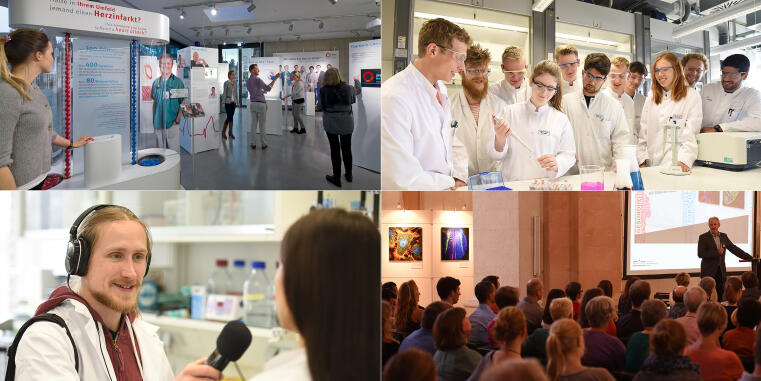What do scientists gain from engaging in public communications?

Scientists who communicate their research to non-scientific audiences experience positive retroactive effects on their scientific work, according to a newly published study. “As a result of their involvement in public outreach, the scientists we surveyed not only perceived an increase in their personal motivation and competence for public communication, but they also saw benefits related to networking and knowledge exchange with colleagues from other disciplines within interdisciplinary research networks,” explains psychologist Dr Friederike Hendriks from the Technische Universität Braunschweig. Together with psychologist Prof Rainer Bromme from the University of Münster, she collected assessments from scientists at Münster University on their involvement in the public communication activities of two interdisciplinary research networks in the field of cell dynamics and imaging. The basic premise, she says, is that scientists who engage in communication with non-scientific audiences need to broaden their own specialised views of their research in order to make complex topics understandable. As the same principle is true for interactions with fellow researchers from other disciplines, communication with people beyond the scientific community can also promote communication between different disciplines within science.
The interviewees reported almost no negative effects related to their community outreach. However, they agreed that they had limited time and resources for such tasks. Furthermore, doctoral students were more hesitant in their assessment of their role in public communications and its benefits than postdocs, who are more advanced in their careers, and professors. “As a scientist, you have to weigh priorities in the face of multiple tasks,” says Rainer Bromme. He emphasises that their study “helps make clear that science communication is not just an effort that you make for other people on top of your many other tasks, that it can also be beneficial for your work,” adding that public communication both demands and promotes reflection on one’s own research and the relationship between science and society.
Crossing boundaries facilitates learning on multiple levels
The positive side effects that the scientists associated with their public outreach activities included finding a “common language” between different disciplines, getting an overview of research projects, and developing a better understanding of the research of their colleagues in other disciplines. In one case, two research groups who collaborated on public outreach activities even went on to undertake a joint scientific project. The majority of interviewees also reported that they enjoyed the activities, perceived an improvement in their public communication skills and were motivated, by their positive experiences, to pursue further engagement. Individuals also reported that interacting with non-expert audiences had encouraged them to reflect on their own work on a more abstract level. These diverse potentials were identified and explored by the researchers who produced this study based on the theory of “boundary crossing”. “When boundaries come up or are even crossed in communication with other people, this opens up avenues for learning about yourself and your conversation partners,” explains Friederike Hendriks.
Science communication as a beneficial joint task
When compared to postdocs and professors, doctoral students rated their own research as less interesting to the public. They were also more likely to think that their careers would not benefit from science communication and that it should be done by experienced people. “As a doctoral student, you usually work on smaller research questions and, only as your expertise develops in your career, can you place them in larger contexts so that they also become interesting for people beyond the scientific community,” explains Friederike Hendriks. She emphasises that it is, therefore, important to design science communication formats and opportunities that are appropriate for doctoral students in terms of content and time. She explains how, in the research networks involved in the survey, this was achieved through, for example, lab workshops for high-school students and contributions to picture exhibitions.
She also highlights that the high level of outreach the scientists interviewed had engaged in shows that research networks can help establish a culture in which communication is seen as a valuable joint task rather than a burdensome additional task. Friederike Hendriks herself is currently working with her junior research group to develop communication training for early career researchers which teaches research-based strategies and skills to support researchers to engage in comprehensible and counterpart-involving conversations about science.
Sample and communication activities in the focus of the study
The team surveyed 75 scientists from various career stages and disciplines – including doctoral students, postdocs and professors from medicine, biology, chemistry, physics, mathematics and computer science – who collaborate in research networks across disciplinary boundaries. The participating networks included the Collaborative Research Centre 656 “Molecular Cardiovascular Imaging” and the “Cells in Motion” Cluster of Excellence at the University of Münster. The focus of the study was on activities initiated by these networks. They ranged from laboratory tours, workshops and lectures for children, young people and adults to exhibitions with interactive exhibits and scientific images, to information media such as websites, brochures, audio and video formats, and press relations.
The study was conducted in 2016 and 2017 and has now been published in the social science journal “Science Communication”. Friederike Hendriks was working at the University of Münster at the time the survey was undertaken.
Original publication
Hendriks F, Bromme R: Researchers’ Public Engagement in the Context of Interdisciplinary Research Programs: Learning and Reflection from Boundary Crossing. Science Communication. First published online November 17, 2022. DOI: 10.1177/10755470221137052
Links
- Original publication in “Science Communication”
- Research group Dr Friederike Hendriks at Technische Universität Braunschweig
- Prof Rainer Bromme at the University of Münster
Author: Doris Niederhoff
English language editing and consulting: Julie Davies

